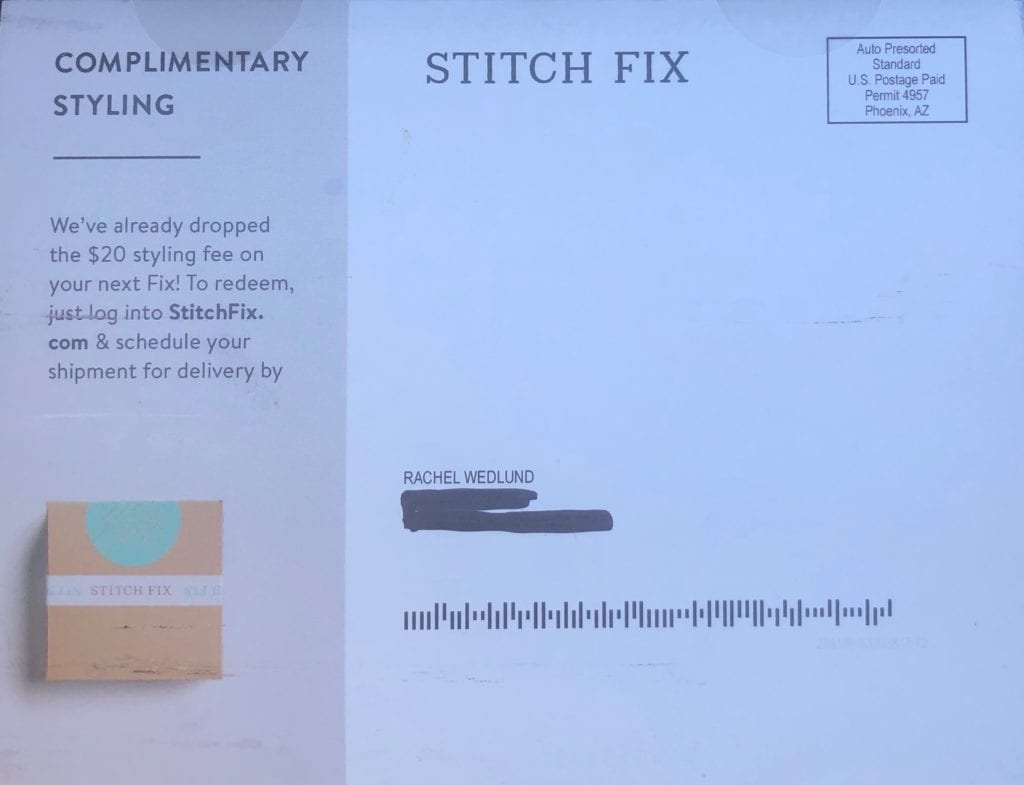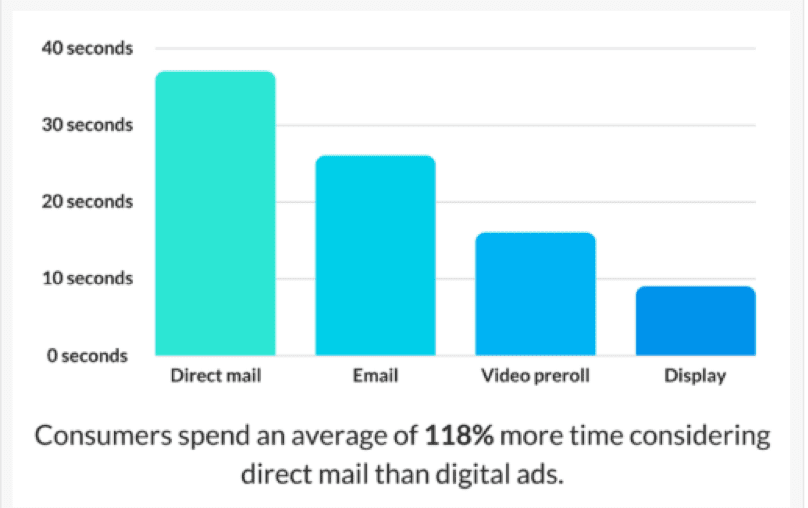Pop Quiz: What do Stitch Fix, Primary, Bite Squad, LendingClub and HelloFresh all have in common?
Yes, they’re all e-commerce brands. But there’s more. They’re e-commerce brands that use variable data to mail targeted or dynamic postcards.
Why, you ask? Isn’t the clientele of an e-commerce brand more likely to respond to digital ads than personalized postcards? Actually, no.
Direct mail garners an average household response rate of 5.1%, according to the Direct Marketing Association. That’s about 10-30x what email, social media and paid search net combined. And when integrated with digital strategies, variable data direct mail can be even more powerful.
Take Stitch Fix, for example. I recently canceled my Stitch Fix subscription. The online personal shopping service probably sent me a few reactivation emails afterward, but I can’t be sure because I stopped reading their emails.
I’m pretty sure I scrolled by a few of their re-engagement ads on Facebook, too, but I mostly tuned them out. But then I received a targeted direct mail offer I couldn’t refuse, delivered right to my home where I couldn’t miss it.


Front of Stitch Fix postcard (Source: Inkit)


Back of Stitch Fix postcard (Source: Inkit)
Free styling on my next Stitch Fix box? Sign me up.
I’m not the only one who’s responding well to targeted direct mail like this. Multiple studies show that marketing postcards not only have high response rates but that they strengthen integrated cross-channel campaigns.
Canada Post found that when direct mail is integrated with digital ads, campaigns got 39% more attention, produced 5% greater emotional impact and achieved 10% higher brand recall.
Direct mail is a very powerful medium for brands—even for companies that operate solely online—when they need to cut through the digital noise to get their message out. Done right, dynamic direct mail can boost online sales and drive engagement online.
Before we get into how and why dynamic postcards work, let’s talk about why direct mail still reigns in the Digital Age.
Why Direct Mail Marketing Is Still Relevant
Many executives believe direct mail is too expensive (and it is more spendy than email and some digital ads); that marketing postcards can’t be highly targeted; and that “junk mail” just doesn’t fit with an e-commerce brand’s tone.
However, today’s direct mail can bring in an impressive ROI, negating printing and postage costs. (For every $167 spent on direct mail, U.S. marketers sell $2,095 in goods).
And direct mail can be just as targeted as anything you’re doing online (especially when you set up Iterable’s direct mail integration); thus, any mail you send can be highly relevant rather than “junky.”
Direct mail is an especially strong channel for e-commerce brands, because:
- Marketing postcards are more memorable than emails and digital ads, giving your audience a tactile experience to associate with your online brand.
- Personalized postcards help you build credibility with your audience, gaining trust and, ultimately, authority.
- Printed media, like direct mail postcards, can push your design team to the next level, as they are forced to consider how your branding translates into print.
- Triggered postcards allow you to reach your customers or prospects even when they ignore your emails. (And according to Marketing Sherpa, you’re going to lose 25% of your email list this year).
- Dynamic direct mail gives you a chance to stand out from your competitors, many of whom probably are not sending personalized postcards. (The amount of mail sent is declining, meaning mailboxes are less crowded, but the vast majority of Americans still check their mail daily.)
- An integrated dynamic direct mail + digital strategy can improve targeting, enhance personalization and increase conversions.
- By combining direct mail marketing with social media (Facebook, specifically), you can increase website visits and conversions.
If your e-commerce brand needs a competitive edge, direct mail is your channel. But how, exactly, can marketers best integrate postcards into their digital strategies?
5 Ways to Leverage the Powers of Personalized Postcards + Digital
Using a cross-channel approach, integrating digital strategies and modern direct mail marketing can increase your response rates significantly.
Here are five ways to leverage the powerful combination of print + digital.
- Use Personalized Postcards for Tagging. If you’re relying solely on digital advertising, chances are you struggle with missing e-mail addresses from time to time. You can build up your contact database with a personalized postcard tagging campaign. Send a postcard that directs recipients to a landing page using a personalized URL (PURL) to get information that is personalized for them. This could be a page to download birthday coupons, for example. The landing page should include a short form that requests the information you need to fill in information gaps.
- Use Dynamic Content Insertion to Mail Relevant Collateral. Consumer demand for personalized content is reaching an all-time high. Direct mail can be highly targeted and personalized. Just as with your digital efforts, you can evaluate behavioral data such as which ads leads have clicked on, which sites they’ve visited and what offers they’ve responded to in order to create powerful, highly relevant direct mail. You can even shape your message and offer using variable data and dynamic content insertion (now available within Inkit’s postcard builder), to create highly relevant direct mail collateral. For example, you might create a holiday mailer that is personalized with a customer’s gift lists, based on gifts a customer has previously purchased.
- Mirror Digital Advertising with Direct Mail Campaigns. Consider pairing a direct mail campaign with digital advertising that uses identical demographic data. You might show prospects the same ad (with slightly different copy and design as warranted by each medium) in their inbox, mailbox and social media feeds. This type of cross-media repetition has been shown to increase response rates by 25% as compared to direct mail alone.
- Give your Cart Abandonment Sequence a Powerful One-Two Punch. You should already be attacking cart abandonment rates with an email sequence. Nearly half of all cart abandonment emails are opened, and 13% of those get clicks. If you’re using Iterable, setting up a cart abandonment series is easy and effective. And by integrating Iterable with Inkit, you can add one more step—one that your competitors are probably skipping: the closer postcard.
- Integrate Direct Mail with Social Media for Increased Engagement. Social media and direct mail may seem like polar opposites, but they are two of the best channels to marry together. You can use your direct mail list online by merging it with Facebook Ads to run hyper-targeted ads to those prospects or lookalike audiences, or you can leverage social media efforts to direct leads to landing pages and collect their addresses. Either strategy empowers you to capture an array of data and further refine your omni-channel efforts.
Whichever direct mail + digital strategies you decide to incorporate, be aware that personalization can make a big difference—just as it does with the rest of your cross-channel approach.
Using Variable Data Printing to Personalize Postcards
Many marketers make the mistake of believing personalization is limited to name and address when it comes to direct mail. Today, you can do so much more. At Inkit, we’ve modernized direct mail to allow marketers to create dynamic direct mail just as easily as emails.
Using our new variable data feature, marketers are better able to personalize and target postcards. You can personalize your postcards using any field you’ve filled out in our campaign builder.
Or, even better, once you integrate Inkit and Iterable you can personalize postcards using any data point you have in Iterable’s platform.


Source: Inkit
Inkit and Iterable built an integration because the powerful tools available within Iterable provide accountability and acuity to direct mail marketing. Additionally, relevant postcards can provide real-world authority and tangibility to the digital campaigns you can run through Iterable.
To put it simply, dynamic direct mail and digital marketing can enhance each other’s strengths as well as make up for any weaknesses when cohesively integrated.
If you’re ready to start powering variable data-driven direct mail through Iterable + Inkit, reach out to us today. We’re happy to get you started.






























